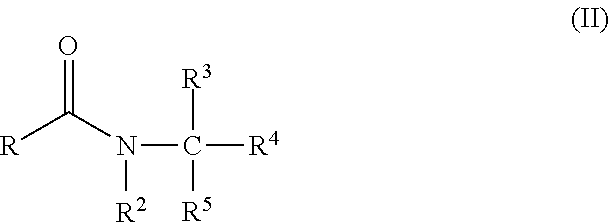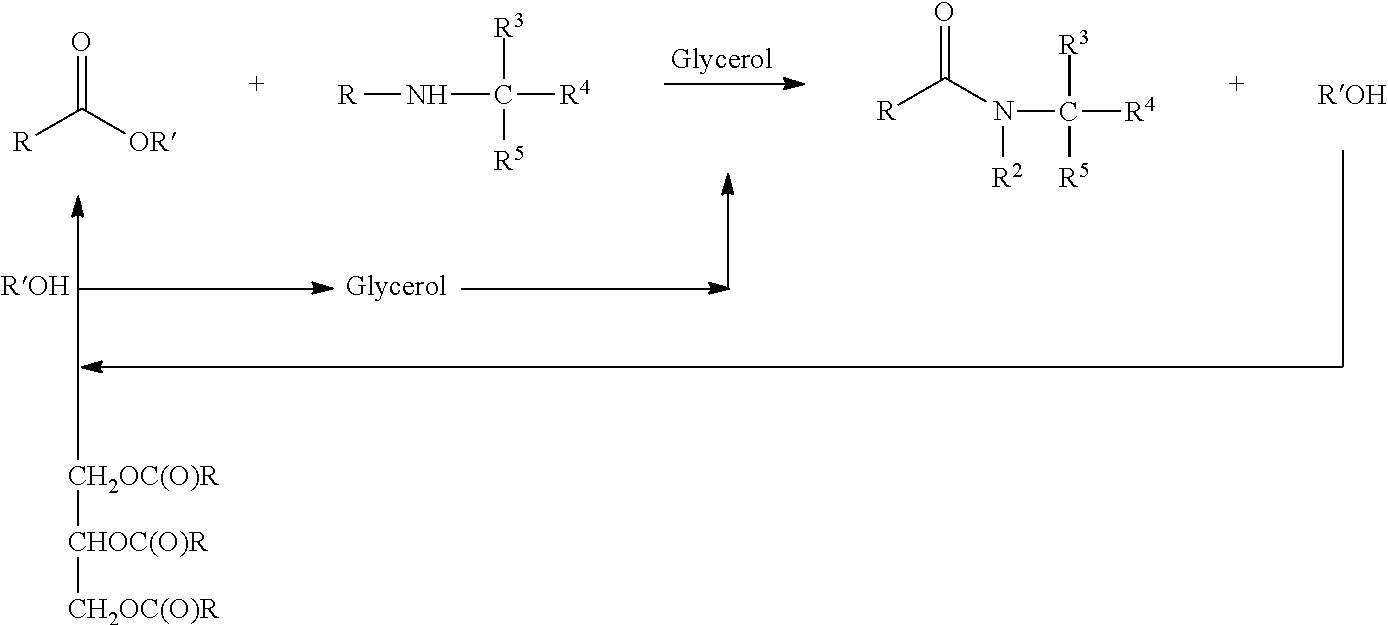Fatty acyl amido based surfactant concentrates
a technology of surfactant concentrate and acyl amido, which is applied in the preparation of carboxylic acid amides, organic chemistry, fatty acid chemical modifications, etc., can solve the problems of incompatibility of unsaturated fatty acids, limited amount and extent of their use, and inability to fully recover the added cost of chlorid
- Summary
- Abstract
- Description
- Claims
- Application Information
AI Technical Summary
Benefits of technology
Problems solved by technology
Method used
Image
Examples
example 1
[0044]Concentrates of sodium cocoylglycinate, as the surfactant component, were prepared by the following procedure. A 250 ml 3-neck glass reactor vessel was used to conduct a series of comparative experiments. A central neck was fitted with a stirring rod with Teflon® blade at one end and a motor for rotating the rod at a second end. A second neck of the reactor was fitted with a water-cooled condenser leading to a Dean-Stark trap for collecting methanol generated in the interesterification reaction. The third neck was fitted with a thermometer attached to a temperature control device. The reactor was externally heated in a glas-col heating mantle. In experiment 1, the reactor was charged with 25 g glycerol, 0.41 g calcium oxide, 17.5 g sodium glycine, and 39 g cocoyl methyl ester. Initially two phases were present in the reactor. The reactants were then heated at 120° C. for 2 hours under constant stirring and dry nitrogen. The reactor contents were then cooled to a point just abo...
example 2
[0050]A series of experiments were conducted to evaluate concentrate formation in reaction mediums other than polyols. The experiments were run with reactants and conditions identical to experiment 1, except where otherwise indicated as footnotes to Table II.
TABLE IIReactionReactionExperimentCalciumMixtureTimeTemp.YieldHunter Lab Color ScaleNo.Medium7OxideBufferpKa(Hours)(° C.)(%)Lab16MethanolYes8None9.6212093.392.0124.3017EthanolYesYes9.64.58093.392.0124.3018Isopropyl AlcoholYesYes9.659093.392.0124.3019TolueneYesNone9.6511093.392.0124.3020Isoamyl AlcoholYesYes99.6512093.392.0124.3021WaterYesNone9.63-595-10068.9312.4436.727Amount of the medium was 100 g.8Doubled CaO to 0.82 g.9Trisodium phosphate doubled to 3.0 g.
[0051]Based on the results reported in Table II, it is evident that methanol, ethanol, isopropyl alcohol, toluene, isoamyl alcohol and water were ineffective in providing any reasonable yields of sodium cocoyl glycinate. Only polyols such as glycerol and propylene glycol we...
example 3
[0052]A set of experiments were conducted to evaluate whether amino acids other then glycine such as amino sulphonic acids and glucosyl amines would also be reactive in the process and form surfactant functional concentrates. The experiments were conducted with reactants and under conditions identical to experiment 1, except glycine was replaced by sarcosine, taurine, or N-methylglucamine.
TABLE IIIReactionReactionExperimentAminoCalciumMixtureTimeYieldTemp.Hunter Lab Color ScaleNo.ReactantGlycerolOxideBufferpKa(Hours)(%)(° C.)Lab22SarcosineYesYesYes9.6255-6512076.755.2453.6423TaurineYesYesYes19.72 95+12093.3−0.126.0724N-methylglucamineYesYesYes9.629212092.144.432.75
[0053]Experiments 22 and 23 produced respectively good yields of sodium cocoylsarcosinate and sodium cocoyltaurate and their concentrates. Amides of N-methyl glucamine were also provided in good yields as detailed in Experiment 24.
PUM
| Property | Measurement | Unit |
|---|---|---|
| Temperature | aaaaa | aaaaa |
| Temperature | aaaaa | aaaaa |
| Temperature | aaaaa | aaaaa |
Abstract
Description
Claims
Application Information
 Login to View More
Login to View More - R&D
- Intellectual Property
- Life Sciences
- Materials
- Tech Scout
- Unparalleled Data Quality
- Higher Quality Content
- 60% Fewer Hallucinations
Browse by: Latest US Patents, China's latest patents, Technical Efficacy Thesaurus, Application Domain, Technology Topic, Popular Technical Reports.
© 2025 PatSnap. All rights reserved.Legal|Privacy policy|Modern Slavery Act Transparency Statement|Sitemap|About US| Contact US: help@patsnap.com



